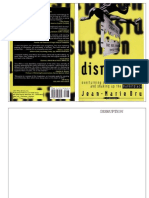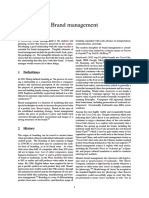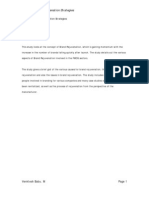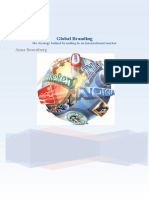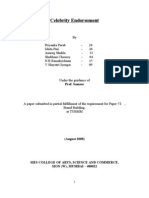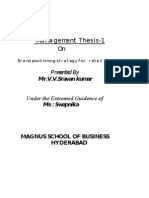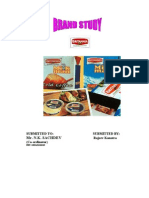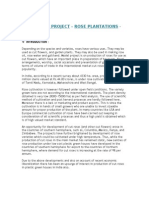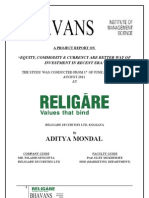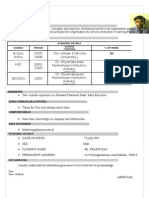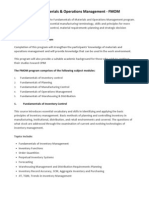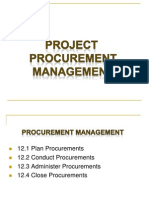Advertising Rejuvenates Brand
Advertising Rejuvenates Brand
Uploaded by
ani2sysCopyright:
Available Formats
Advertising Rejuvenates Brand
Advertising Rejuvenates Brand
Uploaded by
ani2sysCopyright
Available Formats
Share this document
Did you find this document useful?
Is this content inappropriate?
Copyright:
Available Formats
Advertising Rejuvenates Brand
Advertising Rejuvenates Brand
Uploaded by
ani2sysCopyright:
Available Formats
Advertising Rejuvenates brand Brand Rejuvenation Strategies
Summary This study looks at the concept of Brand Rejuvenation, which is gaining momentum with the increase in the number of brands failing quickly after launch. The study details out the various aspects of Brand Rejuvenation involved in the FMCG sectors. The study gives a brief gist of the various causes for brand rejuvenation, the methods of rejuvenation and also the issues in brand rejuvenation. The study includes insights from the people involved in branding for various companies and many case studies of brands that have been revitalized, as well as the process of rejuvenation from the perspective of the manufacturer.
Table of contents Executive Summary............................................................................................1 Acknowledgement.........................................................Error! Bookmark not defined. Table of contents..............................................................................................2 Introduction.....................................................................................................3 Objective of the study........................................................................................4 Significance of study...........................................................................................4 Scope of the study.............................................................................................4 Research Methodology.........................................................................................4 Literature Review..............................................................................................5 Branding......................................................................................................5 Transformation of Commodity to Brand.................................................................6 Brand Life Cycle.............................................................................................7 Brand Revitalization........................................................................................9 Correlation between Repositioning and Rejuvenation..............................................13 Need for Brand Rejuvenation...........................................................................15 Methods of Brand Rejuvenation........................................................................18 The Process of Rejuvenation............................................................................25 Issues in Brand Rejuvenation............................................................................29 Analysis........................................................................................................31 Conclusion.....................................................................................................34 Appendices....................................................................................................38 Appendix 1 - Mapping a Brands Life: The Power Grid.................................................38 Appendix 2 - A Brand Rejuvenation Scorecard..........................................................39 Appendix 3 - Questionnaire.................................................................................41 Bibliography...................................................................................................43 Articles..................................................................................................43 URLs...................................................................Error! Bookmark not defined. Text Books..............................................................................................44
Introduction Brand represents the intellectual and emotional associations that people make with a company, product or person. While the word brand is often used more generally and in a qualitative way, the essence of the brand lies in each of our unique, subjective interpretations, in our understanding of the brandwhich is guided by cultural context, interactions we have had with and about what we are evaluating, and our own personal conception of the world. The science of branding is about designing for and influencing the minds of peoplein other words, building the brand. Brands do have life cycle which may consist of a number of phases from inception to launch, growth, maturing, decline, revitalization, and retirement. Brand Rejuvenation is a process wherein a brand which is on the verge of retirement, is brought back to life to regain markets. Revitalizing a once-popular dormant brand can be a highly profitable strategy under the right circumstances. The marketplace is filled with anecdotal success stories of how brands have been brought back from deaths doorstep. Some of the cases have been adopted in the thesis in order to understand the various needs for, methods of and issues involved in brand rejuvenation. The online survey has helped considering the imminent understanding of the people involved in branding of products and services in various sectors. The study tries to look in to the various difficulties in brand rejuvenation and tries to bring out a model for brand rejuvenation that caters to the needs of brand managers at various organizations.
Objective of the study This study aims to address the issues involved in Brand Rejuvenation Strategies. Significance of study Tired brands can sometimes fade with sales and fashions or simply when they havent been designed for the correct target audience in the first place. The rejuvenation of brands can often result in success for a product, which has entered the later stages of its life cycle. Brand Rejuvenation has a more holistic perspective than repositioning. It creates wider space in terms of market communication that includes escalated advertising and /or repositioning. Scope of the study The study will involve understanding of: 1. Causes for brand rejuvenation. 2. Study of cases involving brand rejuvenation. 3. Issues in Brand Rejuvenations strategies. 4. National and international perspective would be considered. Research Methodology The study would require a combination of primary and secondary research. Primary data would be collected via mail surveys from executives of companies that have taken up brand rejuvenation previously. The study will also involve interactions with brand managers of various companies in Bangalore and Mysore. Secondary data would be taken to understand the branding industry; the trends and issues in brand rejuvenation. The information will be obtained from journals, newspapers and websites.
Literature Review Branding One of the most important yet least understood assets of a company is its brand. In a world besieged with competition and rising consumer expectations, a good product or service has become the cost of entry. Great companies transcend tangible and functional benefits by creating positive emotional ties that can easily outlast any individual product or service. A strong brand builds relationships with customers, which guarantees business for the future. The most valuable property a company acquires over time is its reputation, its goodwill, and its brand name. The word brand is derived from Old English meaning, burning stick. The ancient Egyptians used livestock branding as early as 2700 BC as a theft deterrent, as stolen animals could then be readily identifiable. Around the 10th century merchants marked simple linear designs to prove ownership of goods that were missing due to shipwrecks, pirates, or other mishaps. They were also useful for the tracking of goods by people who were illiterate. The concept of branding in the 21st century grew out of the packaged goods industry, and the branding philosophy has come to include much more than just creating a way to recognize a product or an organization. Branding in the new millennium is used to create an emotional attachment to products and organizations. As a result the stakes involved in launching, maintaining, and evolving a brand are much higher today in the global economy, than they were in the past. According to the American Marketing Association (AMA), a brand is a "name, term, sign, symbol, or design, or a combination of them, intended to identify the goods and services of one seller or group of sellers and to differentiate them from those of competition. Thus, whenever a marketer creates a new name, logo, or symbol for a new product, he or she has created a brand.
A brand is a powerful strategic weapon. It distinguishes a company from its competitors. It defines to the stakeholders, which is the company, what the company believes in and what they may expect from the company. A great brand is a story that is never completely told each new product, promotion or advertisement is just another passage, one more chapter, and one more revealing insight into a complex yet familiar plot. Transformation of Commodity to Brand Brand is a continuum that starts with the most generic form (the commodity) and ends with that most unique and specific of things: a brand. Brand management underlines the fact that brands are not born as brands, but they are born as commodities. For example, more than a century ago, John Pemberton set out to create a tonic, not a global brand named Coca-Cola. And in 1962, when Bill Bowerman and Phil Knight each chipped in dollars 550 to set up Nike, their goal was to make running shoes for athletes, not create a global leisure brand empire. The concept of branding has always been prominent in marketing circles. Recently, it has attracted much broader management attention for a number of good reasons. For many industries, branding offers the best opportunity for creating growth. Branding is applicable to all categories and industries and even applies to commodities. That's because any product or service can be differentiated. And since any differentiated product or service can be given a proper name to signal its particular qualities, branding is possible in every case imaginable The branding of products in what was thought to be commodity categories is so common that we no longer even notice it. Bananas, oranges, flour, aspirin, integrated circuits, paper, carpet
fibers, water, and salt are all "commodity" categories possessing exceedingly profitable brand names. Brand Life Cycle There is a debate in branding circles as to whether or not a brand can have a "life cycle" of its own, or whether its peaks and troughs and just a symptom of managing the brand elements which are, its logo, personality, positioning etc. In a products lifecycle, the peaks and troughs can come in a quicker timeframe, making the cycle more obvious. A brand can have a rise, and then fall out of favor, to be superceded by a new and improved brand. The fact that branding process takes many years affects the universal acceptance of the existence of a brand lifecycle. Without careful management, brands can follow the general pattern of a product lifecycle: moving through introduction, growth, maturity, and decline stages in a relatively rapid fashion. Well-managed brands, however, can prosper almost indefinitely. Numerous studies have shown that many brands that were leading the market years ago are still in that position. To a large extent it has been proved difficult for a challenging brand to overtake them. This means that they have the ability to extend the life cycle or, possibly, the effective marketing of these brands has meant that the life cycle, in its purest form, does not exist. The brand must remain relevant in an ever-changing marketing environment. It must continue to provide consumer value. Optimizing opportunity for the brand is something that should never go out of focus throughout the lifecycle of the brand. Even as considerable time and investment are made in creating and
developing a brand in the lead up to launch, important consideration needs to be given to maintaining and managing the opportunity for that brand following the launch. One of the issues facing brands today and in the future is the apparent shortening of the product life cycle. While many brands continue to lead their markets after many years, others have short life cycles and are frequently designed with this in mind. Brands either live or die. Certain branded products may "die" from obsolescence or changing consumer tastes, but brands can be rejuvenated with new products and services. With well-conceived strategies, a brand can be kept relevant to consumers and last almost indefinitely. Stories of Barbie, Colgate and Kodak justify the possibility. According to a model (Appendix 1) used by a consultant company Landor, a brands position in the life cycle can be known by plotting the brands strength, which is measured with parameters of differentiation and relevance and stature, is measured with parameters of esteem and knowledge. These four parameters are consistently linked with a brand's ability to deliver revenue and profit for its owner no matter the category, no matter the country, no matter the age of the brand. Understanding the position of a brand in its life cycle plays a critical role in the brand managers decisions. A brand can undergo rejuvenation only if it has the potential to come back strongly into the market. It should have a high strength, meaning that the awareness and the knowledge about the brand should be high even the brand may not have a high score in strength.
Brand Revitalization While products often have a lifecycle, we have seen that brands can be eternal. When brands get sick, they can be revitalized. Brands can maintain differentiation, esteem and awareness and thus be able to sustain for a long time. Brand managers may breathe new life into the brand when it seems to be losing its identity. This can be achieved by focusing on renovating offerings. Ghost Brands are brands that are shadows of their former selves. They walk the fine line between life and death, and are often demoted to the bottom shelf, which is the death row in many stores. The companies, which own these brands, have four options: 1) Revitalize them, 2) Milk them, 3) Sell them, or 4) Kill them. Brand Rejuvenation or Revitalization is a major overhaul of a brand, starting with its positioning and proceeding through creative regeneration of the brand identity. Brands like McDonald's pursue an ideal whereby they simply peel off their old skin and relaunch themselves as a new brand. McDonald's new look and new menu offering are methods of rejuvenating the brand. Brands like Adidas, Bank of Baroda, Top Ramen, Kelloggs, Dainik Jagaran, Lifebouy, Liril, Tata Salt, Thumbs Up, Yamaha and TV Today have all worked hard at trying to rejuvenate their image in the consumers minds. Considering the fact that product life cycle and brand life cycle are related, we can understand the requirement of brand rejuvenation by the following figure. Here we see that the
If you feel that your current identity is a millstone around your neck, why not simply wipe the slate clean and create a new one?
rejuvenation strategies are named as injections of new life. These help the company increase the sales and thus improve the brand image of the product. To prolong the life cycle of a brand or product an organization needs to use skillful marketing techniques to inject new life into the product. Products with fewer sales and which are on the brink of exit with damaged brand equity can be termed as the Ugly Ducklings. These include old brands supposedly on their last legs; brands with a loyal but shrinking consumer following; unglamorous cash cows; brands that have built the company; modest volume brands which have had the profit; beasts that never quite broke out of the pack; brands that are put at the lower bottom of the reports. Rejuvenation would be undertaken if the customer target is different and the positioning remain the same as before. This can be understood by the following figure.
10
The Rejuvenation program begins with the creation of a Brand Re-Development Team, just as a new products team, drawing on talents from many organizational areas consisting of energetic loose-cannon manager from creative or marketing services. Competitor analysis is done and finally the team is successful in bringing out a revitalized brand. Reinvention of the company is the real benefit of the Brand Re-Development process. Entire marketing departments, entire corporate structures reinvent themselves through the Brand Rejuvenation approach. The marketing plan has been abandoned in favor of Brand Equity Planning. Monolithic corporate structures can be broken down into smaller entrepreneurial units, and one important byproduct is the discovery that Ugly Duckling brands can be reenergized into profitable, even exciting, Swans. The basic principle of Brand Rejuvenation can be derived from the statement: "Buildings age and become dilapidated. Machines wear out. People die. But what live on are the brands." Sir Hector Laing, Chief Executive Officer, United Biscuits plc. Positioning Platform Market development directed positioning Sustaining positioning Market Penetration directed positioning Radical positioning Rejuvenation Target Customers Same Same Different Different
11
Revitalizing a once-popular dormant brand can be a highly profitable strategy under the right circumstances. Over time, brands build up awareness and name recognition among consumers. People connect emotionally with a brand that reminds them of a specific time, place or experience, and old brands often have a reputation of reliability that new brands cannot match. Bringing back a dormant brand that consumers already recognize and are loyal to can save a lot of money. These savings are in the development, marketing and advertising expenditures that are required to launch a new brand. Making use of pre-existing awareness can also increase a products success rate by helping to cut through the clutter of products in the media.
12
Correlation between Repositioning and Rejuvenation A company must position its brand in the minds of consumers. A brand manager must find something new and different about that brand, get into the minds of consumers, and stake out a bit of territory. A company would like to gain a tiny amount of brain space so that he thinks of the brand while consuming a product in that category. Over time, brand managers will have to reposition a brand. Repositioning a brand requires changing either the target market or the value proposition of the brand. To change the value, we can try to change the core offering itselfthat is, the products or the technology that underlines them, or the brands reputation for quality. Or try changing the experience around the brand. Sometimes, people use the terms brand repositioning and rejuvenation synonymously, but there is a difference between the two terms. Brand rejuvenation is when the brand attributes and overall strategy is still sound, i.e., given the competitive set, customers, industry dynamics that the brand values still are valid, marketable and meaningful (ROI)but there is a need to re-launch the brand messaging strategy. If only some excitement and reminders about the presence of the brand is required, while the basic positioning is still relevant and sound, then "rejuvenation" is the right word. Updating the packaging, perhaps a change in the logo, advertising, etc. could be the solutions. On the other hand, if we have a new and different target audience, or benefits that were never part of the original package, then the brand has to be re-positioned. The brand image has to be
13
changed. Brand repositioning is when we need to reset the brand in terms of values and attributesand then launch a brand messaging strategy. Brand Rejuvenation has a more holistic perspective than repositioning. It creates wider space in terms of market communication that includes escalated advertising and/or repositioning. The relation between rejuvenation and repositioning can be understood with the example of United Airlines. Their brand positioning once way "solid, industry leader, serious, you pay more but you receive higher quality, targeted at professional travelers". If United wanted to revitalize that brand strategy, they would likely launch communications such as interviews, PR, advertising, promotions that would emphasize that brand. On the other hand, if United felt that the next high growth customer demographic is vacation travel and they want to serve that demographic with appropriate brand value, then they would need to "shift" their brand identity though not too drastic so as to isolate the old customers and confuse new targets, but to the extent that they take some of the current valid brand attributes and characteristics and augment them with "flexible, key partnerships" or whatever to reposition it with values that are appropriate for the new target market.
14
Need for Brand Rejuvenation Brands can be understood in four basic stages, without using the life cycle pattern. Brands that have made money, brands that are making money, brands that will make money and brands that will be making money. Brand Rejuvenation can be a formula applicable to brands that are in the first two stages. They need to be brought to level three or four. In simple terms, Brand Rejuvenation is the effort to bring a brand which could not make money into the money making bracket, with a new positioning or communication strategy. As Ogilvy & Mather's Normart Berry once remarked: The brands most likely to respond to revitalization efforts are those that have clear and relevant values that have been left dormant for a long time, have not been well expressed in the marketing and communications recently, have been violated by product problems, cost reductions, and so on. If it is found that the brand really does not have any strong values, chances are that the product or business strength in the past was a function simply of performance and spending characteristics and that, in fact, according to our: definition, it never really became a true brand. Bringing these brands back to life is more like starting from scratch. It really isn't revitalization. At the level at which the buck stops and budgets are decided rejuvenation plays a critical role for a brand to come back to life. Some companies believe reputation matters more than anything else and this is true as the stakeholders of the company already have an impression of the company. Every day, these impressions dictate how people behave towards the company. The question is how much of attention needs to be given to this. This determines whether a company chooses to actively manage these perceptions or leave them to chance. The sum of most of these impressions can be called your as a brand. It tells the world what it can expect from the company.
15
Brand Rejuvenation may be required due to the following reasons A new competitor may have taken over the category and the company is struggling to generate revenues from the current product. A new variant has to be launched in order to regain market share. The whole product or service category may be declining, and a brand could be one of many brands that could use rejuvenation. It makes sense to build the brand while others are lying low because this is the time when the ambience is clutter free and your message gets across to the prospect much more clearly Rejuvenation may be needed in order to communicate category leadership, as well as develop an energized new visual identity system and unify the brand's expressions across all audiences. Rejuvenation may just be a need increase market share as the brand image may be becoming less relevant to people. Customer mindshare definitely translates into market share. It may be time to re-position the product or rejuvenation may be a spike in promotion activity. The brand develops a strong association with the offering and the brand association network gets strengthened with more nodes. Perhaps, the brand has lost its unique point of differentiation and thus looking to revitalize the product or brand with a new image. The target market for the brand has aged, and the brand hasnt managed to renew its positioning in the minds of the next generation of consumers as was the case with. Brand may no longer meet the consumers needs or desires, where in the consumer has shifted to a different platform. Consumers needs have shifted from price to value. The lack of customer understanding of the product, the lack of customer engagement and the lack of customer experience, which would require developing a concept that would achieve high impact and recognition.
16
Rejuvenation may be to modernize the brand identity and making it more accessible. Lackluster market success prompts the need to revitalize the positioning or package design. Existing package design may not have communicated a sense of natural well being which may have prompted the company to completely revamp the package design system, including the brand logo. Apart from the above reasons, neglecting the brand because of overconfidence that the brand is established and can sustain on its own, poor consumer relationship management and lack of appropriate response to increase in competition levels can bring in imperative for Brand Rejuvenation.
17
Methods of Brand Rejuvenation While going for a repositioning, it is important to accurately and completely characterize the breadth and depth of brand awareness; the strength, favorability, and uniqueness of brand association and brand responses held in consumer memory; and the nature of consumer-brand relationships. The brand equity in the minds of the customer has to be analyzed. Else a special brand audit may be necessary. Of particular importance is the extent to which key brand associations are still adequately functioning as points of difference or points of parity to properly position the brand. Decisions must then be made as to whether to retain the same positioning or to create a new one and, if so, which positioning to adopt. The positioning considerations can provide useful insights as to the desirability and deliverability of different possible positions based on company, consumer, and competitive considerations. Sometimes the positioning is still appropriate, but the marketing program is the source of the problem because it is failing to deliver on it. In these instances, "back to basics" strategy may make sense. In other cases, however, the old positioning is just no longer viable and a "reinvention" strategy is necessary. Revitalization strategies obviously involve a continuum, with pure "back to basics" at one end and pure "reinvention" at the other end. Many revitalizations combine elements of both strategies. With an understanding of the current and desired brand knowledge structures in hand, the customerbased brand equity framework again provides guidance as to how .j to best refresh old sources of brand equity or create new sources of brand equity to ,y achieve the intended positioning. According to the model, two such approaches are possible
18
1. Expand the depth or breadth of brand awareness, or both, by improving consumer recall and recognition of the brand during purchase or consumption setting 2. Improve the strength, favorability, and uniqueness of brand associations making up the brand image. This approach may involve programs directed at existing or new brand associations. By enhancing brand salience and brand meaning in these ways, more favorable responses and greater brand resonance can result. Strategically, lost sources of brand equity can be refurbished and new sources of brand equity can be established in the same three main ways that sources of brand equity are created to start with: by changing brand elements, changing the supporting marketing program, or leveraging new secondary associations. The remainder of this section considers several alternative strategies for affecting the awareness and image of an existing brand to refresh old sources or create new sources of brand equity. Making Old Brands New Many once-strong brands wither away into obscurity because their brand managers lose sight of the customer, and choose to attack the competition instead. Brand managers need to focus on the three ways customers interact with a brand. Specifically, managers need to understand how customers perceive, choose, and use the brand. This is because, when most people buy products, they buy 1 or 2 at a time. They anchor on a low number (like 1 or 2), then buy more if the product's on sale. When promotions suggest high numbers people shift their reference point to the higher number, and buy more. Profit pressures on mature brands lead some companies to focus on the competition at the expense of the customer. In the face of these pressures, companies can either fight the competition or shore up the loyalty of existing customers. Increasing customer loyalty has both short and long term benefits, but companies must understand the interaction points between customer and brand, which talks about how customers perceive a brand. In mature brands this point is very essential. The product might have fallen out of favor, or the household might already have the product in inventory and it must be used up before it will be
19
bought again. In these cases choice can influence perceptions and then usage or usage can influence perceptions and then choice. Managing How Existing Users Perceive A Brand In 2002 Lifebuoy was relaunched, marking a new turning point in its history. The new mix included a new formulation and a repositioning of the brand to make it more relevant to both new and existing consumers. Refresh Favorable Perceptions: this is the backbone of the nostalgia campaigns that have resurrected Onida and Hero Honda CD100. By calling up past memories and positive perceptions of a product, the consumer will be more open to any new messages the marketer is sending. Mirc Electronics Ltd, decided to re-launch its well-known Onida Devil campaign to help the brand regain its lost charm. For long, the Onida Devil has been the face of Onida, along with the catch line Neighbors Envy Owners Pride. Associate the Brand with Relevant Goals: over time, consumer wants and needs change. Sometimes an old mature brand must reposition itself as a viable tool to achieve these new goals. Tata Salt conducted studies that showed most people traditionally focus on detailing the functional properties of various brands, and then redesigned their ad campaign to focus on the broader and more fundamental emotional aspects associated with the salt technology. Tata Salt has brought about a distinctive rational differentiation, saltier salt, which reiterates the brands commitment to millions of Indians. Kelloggs is now sold as a convenience food rather than "family breakfast" specialty, due to changing eating habits.
20
Expanding Brand Awareness With a fading brand, often it is not the depth of brand awareness that is a problem- consumers can still recognize or recall the brand under certain circumstances. Rather, the breadth of brand awareness is the stumbling block-consumers only tend to think of the brand in very narrow ways. Therefore, one powerful means of building brand equity is to increase the breadth of brand awareness, making sure that consumers do not overlook the brand and that they will think of purchasing or consuming it in those situations in which the brand can satisfy consumers' needs and wants New Uses that Revitalize Old Brands: Mature brand manufacturers are increasingly researching and developing ways to market new uses for their products. In order to increase the frequency of usage, additional applications of the product, either within the situational category or across category, provides an ample opportunity for increased sales. Associate the Brand with New Usage: By expanding the perceived usage situations for a mature product, product sales can rise, or at least be protected. Cinthol sales increased when it was marketed as toilet soap with deodorizer for the body. This repositioning was vital for Cinthol since the competition was increasing and the market share was shrinking every year
21
Improving Brand Image Although changes in brand awareness are probably the easiest means of creating new sources of brand equity, more fundamental changes are often necessary. A new marketing program may be necessary to improve the strength, favorability, and uniqueness f brand associations making up the brand image. As part of this repositioning to the existing positioning any positive associations that have faded may need to be bolstered, any negative associations that have been created may have I be neutralized, and additional positive associations may have to be created. Repositioning the Brand: In some cases, repositioning the brand requires establishing more compelling points of difference. This may simply require reminding consumers of the virtues of Arm & Hammer Baking Soda is a perhaps the most recognized example of the diversified innovative applications of the product. Baking soda, primarily used for cooking uses, is now found in many household refrigerators as a deodorizer or in bathrooms for dental hygiene. Merrill Lynch, which today is one of the worlds leading financial management and advisory companies, in an effort to address its rather unexciting corporate brand image and show people that it is really a part of the modern hi-tech world, Merrill Lynch has re-engineered its icon (the bull) and embarked on a major advertising campaign that coincides with its entry into online trading. The company has introduced low-cost online investing for customers, and has had to break away from its traditional brokerage image. Whilst the bull remains as a symbol of the power and durability of the Merrill Lynch brand, the new hi-tech bull signifies readiness to fight in the e-commerce market place.
22
a brand that they have begun to take for granted. Kellogg's Corn Flakes ran a successful ad campaign with the slogan "Try Them Again for the First Time." Changing Brand Elements Often one or more brand elements must be changed to either convey new information or to signal that the brand had taken on new meanings because the product or some other aspect of the marketing program has changed. The brand name is the most difficult to change. Packaging, logo and other characters may be changed. Entering New Markets Positioning decisions require a specification of the target market and the nature of competition to set the competitive frame of reference. The target market or markets for a brand typically do not constitute all possible segments that make up the entire market. In some cases, the firm For example, in the early eighties, Harley-Davidson repositioned its brand to be the full-sized, classically styled motorcycle for people who see themselves as individuals. To do so, it targeted a new market and changed virtually, every component of the value proposition. In case of Mountain Dew, the company chose to focus on the personality. Mountain Dew, the ultra sweet, odd-colored lemon line drink marketed by Pepsi, through out its history had targeted youthful drinkers. But, over time, the company steadily shifted its positioning from hick to hip, with great success. Bank of Baroda has totally changed the way it operates. It has changed the logo to a modern signage and has started airing commercials in the media with a brand ambassador. Bajaj Auto also did a similar rejuvenation by changing its management along with the core area of product and the logo. Yamaha today has seen similar changes.
23
may have other brands that target these remaining market segments. In other cases, however, these market segments represent potential growth targets for the brand. Effectively targeting these other segments, however, typically requires some changes or variations in the marketing program, especially in advertising and other communications, and the decision as to whether to target these segments ultimately depends on a cost-benefit analysis. Procter & Gamble executed one classic example of this approach with its Ivory soap, which was revived by promoting it as a pure and simple product for adults instead of just for babies. Johnson & Johnson baby shampoo achieved success by virtue of a similar strategy in which the company promoted the gentleness and everyday applicability of its shampoo to an adult audience. After a century of fighting tooth and nail with archrival Arrow, Van Heusen finally was able to take over the top spot in the dress shirt market in 1991. By devoting half of its $8 million budget to advertise directly to women in women's magazines, Van Heusen was able to influence key decision makers: Women buy an estimated 60 percent to 70 percent of men's shirts.
24
The Process of Rejuvenation In virtually every product category, there are examples of once prominent and admired brands that have fallen on hard times or, in some cases, even completely disappeared. Nevertheless, a number of these brands have managed to make impressive comebacks in recent years as marketers have breathed new life into their customer charter. Brands such as Reader's Digest, Liril, Colgate, Lakme, Britannia and Onida have all seen their brand fortunes successfully turned around to varying degrees in recent years. As these examples illustrate, brands sometimes have had to return to their roots to recapture lost sources of equity. In other cases, the meaning of the brand has had to fundamentally change to regain lost ground and recapture market leadership. Reversing a fading brand's fortunes thus requires either lost sources of brand equity to be recaptured or new sources of brand equity to be identified and established. Regardless of which approach is taken, brands on the comeback trail have to make more "revolutionary" changes than the "evolutionary" changes to reinforce brand meaning. Looking at a few examples of brand rejuvenation models, we can understand that the process of rejuvenation takes more than a few steps to be completed. It is a time consuming project that may call for a separate budget. An overview of the process can be explained in three simple steps. The first thing that is to be done for a brand being rejuvenated is Brand Discovery, which is to find out why it is there and what it wants to achieve. Next, the brand will experience certain process, the revitalization in various aspects. This is referred to as Brand Practices. Last, Brand Maintenance, the hallmark of a great process, the brand will be refreshed, rejuvenated and
25
balanced and, armed with new knowledge and techniques that should stay with it after the process. The process of brand rejuvenation can be understood by taking a couple of examples of the models being used by Brand Consulting firms. Shombit Sengupta, CEO, Shining Strategic Design Company and also known as Redesign Guru, has undertaken many brand rejuvenations. He follows a six-stage process, modified according to the kind of work for each corporation. The first step is a very drastic audit of the company and the different levels of management, to understand, what the company stands for, and what their core competence is. From here, they look at their marketplace, the distribution, everything, how it works across the country. Then, they make an in house Perceived and Potential (P&P) values research, which is very important. Customers perceptual mapping in relation to the competition throughout the country has to be brought. Next, they work out some ideas they have about the strategic orientation, what the company stands for. Getting feedback from the consumer helps in and gaining an insight into the classical values. From the classical values, they focus on some potential thoughts, which are usually very hypothetical. They try to understand what the perception of the global corporation is. Later, when trying to go for the potential value, they put out some ideas in order to make the values clearer. Then they fine-tune, and go on to another stage, the national P&P research with the help of research agencies.
26
The sixth stage is the finished artwork and the strategic orientation: how it should be communicated. All advertising, all communication strategy, whatever it is in the share market, everything should include the core benefit of the product. At this stage, they interact with the marketing team of the client for the training programme, telling them how to implement, which is very important. Another model used by Rajiv K. Badlani at Norquest Consulting, Ahmedabad is given below. He talks about bringing in a synergy between the vision, mission statements of the company along with the intents, strategies, facts and analysis. The management plays a critical role in the success of the brand rejuvenation process. As depicted in the picture, the management has an influence to all of the factors. As a result of Brand Rejuvenation, the stakeholders of the company now see the company, as it would like to be seen, may be as it was seen before it lost its brand equity. The ensuing goodwill allows goals to be achieved with less resistance, effort and expenditure.
27 28
Issues in Brand Rejuvenation A brand manager has to consider a few issues while undertaking a brand rejuvenation. Following are a few issues in brand rejuvenation. Revitalizing can end up with the brand losing its identity for the sake of introducing new features or cramming more benefits. Managers attempt to reposition individual brands independent of the portfolio. Certain brands do well when they are under the cluster of brands from a company. When they are positioned separately, they may lose their identity and thus the customers. Conventional thinking in the marketing function does not lead to successful Brand Rejuvenation. This calls for some basic recruitment in at all levels of the company. Brand rejuvenation should be accepted at all levels and departments of the company namely, the marketing, finance, human resources and the operations. The Brand Aesthetics, with regard to brands, which are being given a new lease of life at the same platform, can be affected. Some basic features and benefits may be found missing if the customers look for older options. The brand may be repositioned weaker than its old positioning. Perception about the product has to be changed in the minds of the customers. This could act as a challenge for the management. Customers may not be ready to accept the new product when the promotional activities do not exhibit the changed brand. Market may not respond when the demand for the product is not on the rise. Usually, brands are revitalized when the demand for the product category is on a high. The financial aspect in brand rejuvenation plays a major role. The Investment decisions are very critical. Brand Rejuvenation is sometimes compared to a calculated gambling, as the returns cannot be predicted. The return on investments is not guaranteed, as it depends on various factors. Budgeting for brand rejuvenation has to be done at the year-end of the previous financial year.
29
The Channel plays a major role for the success of a brand revitalization activity. The response from the distribution channel has to be positive. They need to carry the brand with a difference. Education of the channel becomes critical. An over reliance on quick-fix advertising instead of addressing more fundamental product performance problems can be an issue while developing a new communication strategy. Rejuvenated brands do not perform well after rejuvenation because they look only at the advertising aspects while neglecting the others. The pace of technological change, which is shortening product life spans, can act as an issue during rejuvenation. From product innovation to parity to obsolescence is a much faster route, making effective brand rebuilding at the product level more difficult. Ever-increasing channels of communications, the Internet and new global markets, provide an opportunity and a threat to the brand builders. They create new opportunities to create truly global brands, but they need a lot of contemplation, as they are not stable. A growing sophistication in the way companies view brand equity and manage their brand development, which is leading to new, better models of brand architecture.
30
Analysis An online survey was created in order to get the insights of the people involved in branding. A questionnaire (Appendix 3) was used to gain the responses about a few parameters of brand rejuvenation. The major questions included the need or the cause for brand rejuvenation, the amount of time anticipated to carry out a brand rejuvenation process. The respondents were given ten major causes for brand rejuvenation to choose the most feasible cause. According to the respondents, loss of market share is the most recurring cause for brand rejuvenation. Respondents also say lack of product differentiation and declining product category prompts for brand rejuvenation. Three out of the five respondents have signified that brand rejuvenation is usually a promotional activity and it is not for bringing in invention to the product. Overall the responses suggest that the causes for rejuvenation are not always common. When questioned about the time frame required for a brand rejuvenation process to be carried out, the respondents feel that the time can be estimated. The reasons or the methods for estimation vary among the respondents. Three of the five respondents feel that market situation can be a major factor in determining the time required for the activity. Previous success of the brand and the intensity of competition can be factors to some extent. The responses for the question regarding the fear of a brand losing its old identity, respondents feel that using new features to promote can be a method of doing this. They also felt that losing the old identity would be better for the brand in order to achieve successful brand rejuvenation. Retaining certain attributes of the old product can facilitate brand positioning and gain markets. The marketer has to carefully position the brand such that it allows the brand to have a normal and organic growth. Meaning, if brand extensions/non-complimentary
31
features are to be introduced, then the brand's positioning should allow this to appear as natural for the consumer. If it does not, then the consumer will get confused and often the brand suffers as a result. Conventional thinking is said to affect the rejuvenation process. It is felt that conventional thinking would retard the process or lead to a repetition of the old stuff. Usually, unorthodox, out-of-ordinary measures typically get the necessary attention and window-of-opportunity from consumers. This acts as a great runway in which to re-launch the brand. The methods of overcoming this can be recruiting, outsourcing the activity of brand rejuvenation. A respondent also felt that conventional thinking would not affect the rejuvenation process as the team may require some conservative thinking and traditional knowledge to be applied for brand rejuvenation. What help will be out-of-the box execution ideas. Brand aesthetics may or may not be retained while a brand is being rejuvenated. This question derived mixed response from the respondents with two of them saying that the aesthetics have to be retained and the other two saying that there should be a change in the brand aesthetics. A question regarding the method of shifting consumer perception generated a response stating that the brand essence shall be changed in order change the perception. Repositioning the brand was another option the respondents feel would change the perception of the consumers. Scheduling of the brand rejuvenation program, according to the respondents depends on the market situation. This is because of the fact that relauching a brand should be at a stage when the market has a demand for the product category. The decision, according to the respondents, has to also depend on the brands health and the competition.
32
According to the respondents, a budget for the rejuvenation process has to be prepared at the beginning. One of the respondents feels that a separate budget need not be prepared for the purpose of brand rejuvenation. Respondents feel that a set pattern or model cannot be followed for rejuvenation. They feel that different brands have to be revitalized in different ways as their position could be at different levels. Certain models do not fit to the Indian context and some brands cannot be rejuvenated in a simple straightforward pattern. The general ingredients according to them would be building awareness, involving channel partners by allowing better margins.
33
Recommendation Factors influencing Brand Rejuvenation
Vision,
The model suggests the various factors that influence the process of brand rejuvenation. The very creation of a brand is influenced by the purpose or the goal of a brand. The major decisions about a brand would dependent on why the brand was created; the basic idea of a brand or a product would be generated after the need is assessed. A brand audit may be necessary for certain brands in order to get the entire history and perception of a brand. This may give us the cause of under taking brand rejuvenation. In order to make successful brand rejuvenation, we have to bringing in a synergy between the vision, mission statements of the company along with the intents, strategies, facts and analysis. The management plays a critical role in the success of the brand rejuvenation process. Brand
Rejuvenation Corporate 34
As a result of Brand Rejuvenation, the stakeholders of the company now see the company, as it would like to be seen, may be as it was seen before it lost its brand equity. The ensuing goodwill allows goals to be achieved with less resistance, effort and expenditure. Relations between need and the method of brand rejuvenation
Com
The above model tries to relate the various factors that bring about the necessity of brand rejuvenation and the various methods available for brand rejuvenation. If the cause for brand rejuvenation is the product itself, i.e., the product has lost its appeal or usage, and the market is not accepting the brand. The product attributes have to be changed and the company may bring out newer uses of the product so that the product is relaunched in Product
Customer 35
the market. The positioning may have to be changed on the whole. This can be done brand requires establishing more compelling points of difference. This may simply require reminding consumers of the virtues of a brand that they have begun to take for granted. When the cause for brand rejuvenation is the customers, it prompts the company to change the perception in the minds of the consumers. Bringing out new uses will also affect the consumers and thus change the brand image. If the reason for rejuvenating a brand is the competition, which has affected the sales and the image of the brand, the company may have to undertake the process in more than a couple of ways. It could be done through entering into newer markets or changing the brand elements and the perception in the minds of the consumers so that the market share is picked up. If the brand rejuvenation is prompted as a result of the failure of the strategies of the brand, the company may have to get into strategies that may be focused towards the changing of brand image, perception in the minds of the consumers and competitors or entering into newer markets and also making a better positioning strategy.
36
Conclusion Brands must make the product relevant and meaningful for the target customers. It must enhance the product over and above the basic generic level. A product that comes off the assembly line tends to be merely a physical object. Branding pushes the product into a perpetual realm by integrating what it is. Branding gives the customers reasons to buy and use the products. Brand rejuvenation gives a second life for a brand. More than 80% of the brands that are launched die off, a mere 8% of these brands, which are retiring, try to rejuvenate the brand. Today Brand Rejuvenation is in very high demand as companies realize that building a brand would take ten times more money than rejuvenating an existing brand. New product development tries to create brand equity from a blank sheet of paper. But it can frequently be more rewarding to start with a sheet already written on, with a hidden message we can decode for a relatively small investment. Many companies have identified the necessity of Brand Rejuvenation and entrepreneurs have brought in Brand Spas to rejuvenate, indulge and refresh the brands. While understanding the importance of brand rejuvenation, I would like to mention the title an article where there is a question posed to the public, Does God need a rebrand? thus brand rejuvenation has reached a stage where even god may use it if he faces a difficulty of losing his charm. Most dead brands died not with a bang but a whimper. This paper has examined the revitalization of established brands; a topic that has been overlooked for too many years. Brand managers have numerous options for revitalizing the sales of an established brand in a mature category. The strategies suggested here present opportunities for many managers to salvage and leverage the equity that has been built over the lifetime of the brand. Brands die because of neglect and consumer indifference. While bad brands may fade away, I say, A good brand though, should never go.
37
Appendices Appendix 1 - Mapping a Brands Life: The Power Grid Brand Asset Valuator, a brand consultant company uses a two-dimensional plot to measure Brand Strength and Brand Stature. The strength is measured on the vertical y-axis with parameters of Differentiation and Relevance and stature is measured on the horizontal x-axis with parameters of Esteem and Knowledge. The Power Grid provides a model for mapping and diagnosing the life of a brand. New brands begin in the lower left quadrant with low strength, low stature. As the brand develops, it rises to the upper left quadrant where strength is significantly higher than stature. It is here where niche brands and brands with unrealized potential reside. This is high margin territory. In order to maximize shareholder value, brands should be strategically leveraged to move to the upper right quadrant, where powerful leadership brands reside. When brands get into trouble, the first thing to erode is Differentiation, causing leadership brands to decline. This loss in Differentiation reduces the ability to extend the brand across new consumer and market segments. As a result, there is a huge loss in intangible value. A brand in Quadrant 2 would be an ideal candidate for Brand Rejuvenation. Brands in quadrant 3 would be quite challenging for a company trying to revitalize it. Brand Rejuvenation can put a brand back into quadrants 1 or 4, depending on the existing market potential for the product line. BRAND
STATURE (Esteem & Knowledge) Niche / Unrealised Potential LeadershipNewUnfocused Declining Eroding BRAND STRENGTH (Differentiation and Relevance) LowHigh LowHigh 143 2 38
Appendix 2 - A Brand Rejuvenation Scorecard Suppose we systematically and quantitatively analyzed the winners and losers in the Brand Revitalization Arena. What would such a Brand Revitalization Scorecard tell us? To develop a Brand Revitalization Scorecard, a research team at the Food and Brand Lab at the University of Illinois selected 42 recently revitalized brands. They were brands such as Altoids, Ovaltine, and Aqua Velva, which had been around for an average of 53 years, and whose sales had recently increased by at least 500% due to revitalization efforts. After selecting these brands, 42 additional category-matched brands were selected which had not been successful in revitalizing themselves. 350 consumers from the Food and Brand Lab Revitalization Panel then evaluated all 84 brands. They were rated on characteristics such as their packaging, advertising, price, distinctiveness, and quality. Two-stage discriminate analyses were then used to relate these characteristics to the time series sales data that had been collected for each product. After the statistical analysis, there were five characteristics that systematically and consistently had differentiated revitalized brands and others. Below is the Brand Revitalization Scorecard: 1. Moderate to Premium-priced. Part of the equity and value of these 42 revitalized brands is that none had ever been heavily discounted or seen as a budget brand. Revitalizing an overpriced product bodes better for success than trying to revitalize an under-priced one. 2. Under-advertised and Under-promoted. Compared with other brands in their categories, 93% these revitalized brands were seen as quiet brands. Consider Ovaltine, once the revitalization effort kicked in, even in expensively produced awareness generating radio ads lead to dramatic sales increases. The latent loyalty was there; all that was needed was to remind people the product was still around. 3. Wide distribution While quiet and all-but-forgotten, many of these revitalized brands were always able to maintain some shelf presence. They may have dropped to the bottom row, or they may have been periodically replaced with a line extension, but they didnt have to fight stores for reintroduction. 4. Long-held heritage The average brand had been around for 53 years. In 87% of these cases, there were vivid memories associated with the brand among at least a small core of the market. This core often played an important part of helping the brand in its first stages of revitalization.
39
5. A Distinct Point-of-Differentiation The importance of differentiating a product is not news to any marketer, but doing it is a talent. Revitalized products had unique points of differentiation that set them apart from the competition in 88% of the cases. Sometimes these points of differentiation had little to do with the tangible functionality of the product, but were related to advertising, a spokesperson, packaging, a well-known theme song, or to style. This Revitalization Scorecard has five criteria. Ever revitalized brand met at least three of these criteria, and 32 of 42 had all five. Many factors go to a decision to revitalize a brand. Let history help. If a brand doesnt score at least 3 on the scorecard, it might be better to move on.
40
Appendix 3 - Questionnaire Please rank the responses in question 1. Ranking should be according to the chances of each option arising. (1 rank is the highest while 5 ranks lowest) Ranking is not relative. 1. Why does the need for Brand Rejuvenation arise? 1 2 3 1 2 3 1 2 3 1 2 3 1 2 3 1 2 3 1 2 3 1 2 3 1 2 3 1 2 3
4 4 4 4 4 4 4 4 4 4
5 5 5 5 5 5 5 5 5 5
You might also like
- Disruption - The Print VersionDocument127 pagesDisruption - The Print Versionlauranedelschi100% (6)
- Role of Brands and Scope of BrandingDocument9 pagesRole of Brands and Scope of BrandingT.RaveendrabharathiNo ratings yet
- Brand Leadership: Building Assets In an Information EconomyFrom EverandBrand Leadership: Building Assets In an Information EconomyRating: 5 out of 5 stars5/5 (3)
- Prof. Ryan C. Roque, CPA, MBADocument109 pagesProf. Ryan C. Roque, CPA, MBASadAccountantNo ratings yet
- Brand ManagementDocument4 pagesBrand Managementalberto micheliniNo ratings yet
- 4564-2469-13-00-40 - SQA IMM Assignment Only V3 Turnatin FileDocument36 pages4564-2469-13-00-40 - SQA IMM Assignment Only V3 Turnatin FileHussain K.JamalNo ratings yet
- Brand Rejuvenation Expect Advertising IncDocument44 pagesBrand Rejuvenation Expect Advertising IncAlejandro MilaNo ratings yet
- Brand Rejuvenation by Surbhi, Swarnim, Swati & VivekDocument28 pagesBrand Rejuvenation by Surbhi, Swarnim, Swati & VivekSwarnim LataNo ratings yet
- Learn Branding Through Case StudiesDocument28 pagesLearn Branding Through Case StudiesSadaf ZahraNo ratings yet
- Brand RecallDocument44 pagesBrand RecallRiddhiman MitraNo ratings yet
- Brand Management of HULDocument76 pagesBrand Management of HULMohammed Yunus100% (1)
- 12 Chapter1Document109 pages12 Chapter1Mumtahin Ul KousarNo ratings yet
- Brand Management 1Document8 pagesBrand Management 1Shah MuradNo ratings yet
- Birla TyresDocument45 pagesBirla TyresPrinZe BharatNo ratings yet
- Brand PromotionDocument89 pagesBrand PromotionHarsh SavlaNo ratings yet
- Ad Project PDFDocument81 pagesAd Project PDFfkkfoxNo ratings yet
- Aida PDFDocument81 pagesAida PDFfkkfoxNo ratings yet
- Aida PDFDocument81 pagesAida PDFfkkfoxNo ratings yet
- BrandingDocument47 pagesBrandingAmrit Banka86% (7)
- Building A Brand: QualityDocument38 pagesBuilding A Brand: Qualitysanjayarora73No ratings yet
- Brand Mascots FullDocument56 pagesBrand Mascots FullKaizad JokhiNo ratings yet
- Sources of Brand ImageDocument20 pagesSources of Brand ImageBhaveshNo ratings yet
- BM Univ QN Paper With AnswersDocument47 pagesBM Univ QN Paper With Answersqwertyuiop0% (1)
- Sem 8 SeminarDocument34 pagesSem 8 Seminardarshan ramoliaNo ratings yet
- Final Airtel ProjectDocument81 pagesFinal Airtel ProjectOMSAINATH MPONLINENo ratings yet
- Global Branding: Anna RosenbergDocument9 pagesGlobal Branding: Anna RosenbergAnna Christina RosenbergNo ratings yet
- Project FulDocument56 pagesProject FulMUKESH MANWANINo ratings yet
- Analysis": Study On "Brand Recall - Survey andDocument23 pagesAnalysis": Study On "Brand Recall - Survey andRamesh Kumar MurugesanNo ratings yet
- Brand Equity Thesis PDFDocument6 pagesBrand Equity Thesis PDFsheilabrooksvirginiabeach100% (2)
- Celebrity Endorsement: Prof. SameerDocument40 pagesCelebrity Endorsement: Prof. SameerAshutosh GauravNo ratings yet
- The Essentials of Branding - Thinking - LandorDocument11 pagesThe Essentials of Branding - Thinking - LandorInternetian XNo ratings yet
- Tuna Balıkçıoğlu - The Basics of Brand ManagementDocument18 pagesTuna Balıkçıoğlu - The Basics of Brand ManagementNatalia NeyNo ratings yet
- 1 Contextualising Your Practice-Essay by (Student Name)Document21 pages1 Contextualising Your Practice-Essay by (Student Name)Shabi ZeeNo ratings yet
- A Study On Brand IdentityDocument32 pagesA Study On Brand Identityk eswariNo ratings yet
- Strategic Significance of The BrandDocument9 pagesStrategic Significance of The BrandWarren Joyce CarandangNo ratings yet
- Brand Management NotesDocument17 pagesBrand Management NotesNishant Sood100% (1)
- Brand StrategyDocument8 pagesBrand StrategyReda LouanziNo ratings yet
- Citizen Brand: 10 Commandments for Transforming Brands in a Consumer DemocracyFrom EverandCitizen Brand: 10 Commandments for Transforming Brands in a Consumer DemocracyNo ratings yet
- Branding and Special Focus On Toon Branding 97-2003Document87 pagesBranding and Special Focus On Toon Branding 97-2003Manasi Ghag100% (1)
- Keegan 6e 10 ImDocument23 pagesKeegan 6e 10 ImPaul LeichtNo ratings yet
- Ma Na Gement Thesis-1 On: Presented by Mr.V.V.Sravan KumarDocument12 pagesMa Na Gement Thesis-1 On: Presented by Mr.V.V.Sravan KumarvakatiNo ratings yet
- Brand Life Cycle (Ground Realty) MDDocument28 pagesBrand Life Cycle (Ground Realty) MDMohit DamaniNo ratings yet
- A Major Project On Evaluation of NationalDocument16 pagesA Major Project On Evaluation of Nationalshikha sharmaNo ratings yet
- Corporate Branding: Corporate Brand - Thinking Beyond The CustomerDocument7 pagesCorporate Branding: Corporate Brand - Thinking Beyond The CustomerShivam Arya100% (1)
- Brand Awareness of AirtelDocument85 pagesBrand Awareness of Airtelvittamsetty72% (18)
- Corporate Souvenir For Branding PubliclyDocument39 pagesCorporate Souvenir For Branding PubliclyAbdullai LateefNo ratings yet
- Is Brand Everything? Issues and Challenges of Branding in Global MarketDocument5 pagesIs Brand Everything? Issues and Challenges of Branding in Global MarketInternational Journal of Application or Innovation in Engineering & ManagementNo ratings yet
- Assignment Assignment: Brands BrandsDocument8 pagesAssignment Assignment: Brands BrandsRajinder SinghNo ratings yet
- An Introduction To BrandingDocument3 pagesAn Introduction To BrandingManoj MgNo ratings yet
- LECTURE 3 - Brands and BrandingDocument15 pagesLECTURE 3 - Brands and BrandingSi Nguyen QuocNo ratings yet
- Mr. N.K. Sachdev: Submitted To: Submitted By: Rajeev Kanotra (Co-Ordinator)Document48 pagesMr. N.K. Sachdev: Submitted To: Submitted By: Rajeev Kanotra (Co-Ordinator)Rajeev KanotraNo ratings yet
- Brand ManagementDocument5 pagesBrand ManagementAbhijit Nandi0% (1)
- Retail Branding Strategyt200813 PDFDocument337 pagesRetail Branding Strategyt200813 PDFSolomon Siddharth1996No ratings yet
- A ConceptualDocument15 pagesA ConceptualAbhishek BehlNo ratings yet
- Branding: Definition: The Marketing Practice of Creating A Name, Symbol or Design That IdentifiesDocument6 pagesBranding: Definition: The Marketing Practice of Creating A Name, Symbol or Design That IdentifiesShailesh SomatkarNo ratings yet
- Branding &client Servicing in Nutracitical Industry.: Submitted by Bavithra.S.B M.O.P Vaishnav College For WomenDocument39 pagesBranding &client Servicing in Nutracitical Industry.: Submitted by Bavithra.S.B M.O.P Vaishnav College For WomenSakthi VelNo ratings yet
- Guide Engaging Marketing and Branding TeamsDocument23 pagesGuide Engaging Marketing and Branding TeamsJobin JoshuaNo ratings yet
- The Brand Gym: A Practical Workout to Gain and Retain Brand LeadershipFrom EverandThe Brand Gym: A Practical Workout to Gain and Retain Brand LeadershipNo ratings yet
- Branding to Differ: The Brand Building Handbook for Business Leaders.From EverandBranding to Differ: The Brand Building Handbook for Business Leaders.No ratings yet
- The Visionary Brand: The Success Formula Behind the Worlds most Visionary BrandsFrom EverandThe Visionary Brand: The Success Formula Behind the Worlds most Visionary BrandsNo ratings yet
- Kellogg on Branding: The Marketing Faculty of The Kellogg School of ManagementFrom EverandKellogg on Branding: The Marketing Faculty of The Kellogg School of ManagementNo ratings yet
- Financial - Accounting - and - Analysis - Assignment - Dec - 2020 - NmPXMM5fmB COMPLETE PDFDocument5 pagesFinancial - Accounting - and - Analysis - Assignment - Dec - 2020 - NmPXMM5fmB COMPLETE PDFani2sysNo ratings yet
- Management - Theory - and - Practice - Assignment - Dec - 2020 - MxdLuixH5s COMPLETE PDFDocument5 pagesManagement - Theory - and - Practice - Assignment - Dec - 2020 - MxdLuixH5s COMPLETE PDFani2sysNo ratings yet
- Financial - Accounting - and - Analysis - Assignment - Dec - 2020 - NmPXMM5fmB COMPLETE PDFDocument5 pagesFinancial - Accounting - and - Analysis - Assignment - Dec - 2020 - NmPXMM5fmB COMPLETE PDFani2sysNo ratings yet
- Akshaya Vanam: Indian SandalwoodDocument52 pagesAkshaya Vanam: Indian Sandalwoodprasadgss100% (4)
- Business Economics - Assignment Dec 2020 8c9w6ILdod COMPLETEDocument8 pagesBusiness Economics - Assignment Dec 2020 8c9w6ILdod COMPLETEani2sysNo ratings yet
- Rose Plantations Project ReportDocument14 pagesRose Plantations Project ReportSumeet Pujari100% (3)
- Rose CultivationDocument16 pagesRose Cultivationani2sysNo ratings yet
- ADITYA MONDAL Final Report (NEW) Print Out.....................Document66 pagesADITYA MONDAL Final Report (NEW) Print Out.....................ani2sysNo ratings yet
- Abhik ResumeDocument1 pageAbhik Resumeani2sysNo ratings yet
- Indian Logistics IndustryDocument77 pagesIndian Logistics IndustryRajnish Thakur100% (6)
- Mathematics PDFDocument316 pagesMathematics PDFShawn JacobNo ratings yet
- Thums UpDocument29 pagesThums UpsvasandNo ratings yet
- ADIT Transfer Pricing Module BrochureDocument48 pagesADIT Transfer Pricing Module BrochureJohn RockefellerNo ratings yet
- Fundamentals of Materials Operations ManagementDocument3 pagesFundamentals of Materials Operations ManagementEmmanuel PetersNo ratings yet
- Toteistic Business PlanDocument22 pagesToteistic Business PlanAnthony BareraNo ratings yet
- Unleashing The Power of MarketingDocument15 pagesUnleashing The Power of MarketingaamirkanNo ratings yet
- Resume Objective For RetailDocument8 pagesResume Objective For Retailafmroxbsdatkff100% (1)
- 2024 Lagos Business School Calendar of Programmes UpatedDocument4 pages2024 Lagos Business School Calendar of Programmes UpatedTodimu01100% (2)
- Introduction To Aviation IndustryDocument10 pagesIntroduction To Aviation IndustryMohd MohsinNo ratings yet
- Eqology - EQ BUSINESS PARTNER AGREEMENTDocument23 pagesEqology - EQ BUSINESS PARTNER AGREEMENTSimasNo ratings yet
- Case 4 Harringtom Collection+Financials - Mar2Document11 pagesCase 4 Harringtom Collection+Financials - Mar2Ameen Almohsen100% (1)
- Case Study 1 7Document14 pagesCase Study 1 7Jamie Rose AragonesNo ratings yet
- Export Strategy: TO or To Export: That'S The Question?Document17 pagesExport Strategy: TO or To Export: That'S The Question?Tram NguyenNo ratings yet
- Trademarks and Twitter: The Costs and Benefits of Social Media On Trademark Strength, and What This Means For Internet-Savvy CelebsDocument25 pagesTrademarks and Twitter: The Costs and Benefits of Social Media On Trademark Strength, and What This Means For Internet-Savvy CelebsNew England Law ReviewNo ratings yet
- Chapter 17 Direct and Online MarketingDocument35 pagesChapter 17 Direct and Online MarketingGautham KarunaNo ratings yet
- Annexure III Curriculum & Detailed Syllabus - Electric Motor Rewinding - 0Document9 pagesAnnexure III Curriculum & Detailed Syllabus - Electric Motor Rewinding - 0Reynaldo PesqueraNo ratings yet
- LGDocument23 pagesLGPathikaryNo ratings yet
- Project Procurement and RiskDocument200 pagesProject Procurement and RiskAlam Khan100% (2)
- Big Data For Marketing Resource ReallocationDocument31 pagesBig Data For Marketing Resource ReallocationBarunNo ratings yet
- Case Solution Product Management PCDocument10 pagesCase Solution Product Management PCDevark ChauhanNo ratings yet
- Kotler Mm15e Inppt 11Document33 pagesKotler Mm15e Inppt 11ASHISH YADAVNo ratings yet
- Rural Marketing Distribution ModelsDocument22 pagesRural Marketing Distribution ModelsDivya Agarwal100% (2)
- Company Profile & JD - Asahi India Auto GlassDocument2 pagesCompany Profile & JD - Asahi India Auto Glassharryyn1990No ratings yet
- 65 Premium FontsDocument68 pages65 Premium FontsRakesh0% (3)
- Business Plan: Prepare by Hau Teen Yee FabriceDocument26 pagesBusiness Plan: Prepare by Hau Teen Yee FabricekarimanrlfNo ratings yet
- Indian Biscuit MarketDocument15 pagesIndian Biscuit MarketRitushree RayNo ratings yet
- 10 Deadly Mistakes of EntrepreneurshipDocument3 pages10 Deadly Mistakes of EntrepreneurshipHassan HameedNo ratings yet
- Contemporary Issues in Marketing ManagementDocument21 pagesContemporary Issues in Marketing ManagementhannaNo ratings yet

